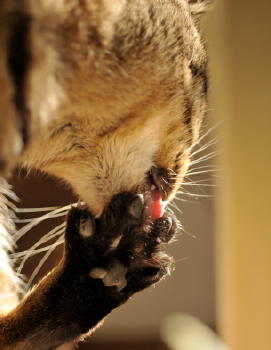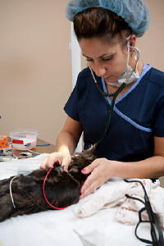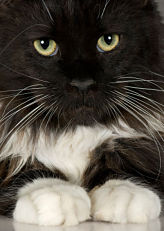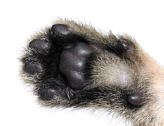Declawing cats is major surgery

I am not a fan of declawing cats and consider it to be a cruel thing to do to a cat. There is considerable controversy on the topic of onychectomy (declawing). Myself, many veterinarians and humane organizations oppose this practice because it entails an irreversible amputation and offers no health benefits to the cat.
Veterinarians who perform this procedure argue that it is an option when a cat is highly destructive scratcher and the owner is considering euthanasia. This is an emotionally charged issue with strong opinions on both sides, so if you have a destructively scratching cat, review the facts before you make any decision.
Declawing Cats Surgery
Cats use their front claws for scratching so these are the ones removed. With the cat under general anesthesia, the vet clips and cleans the paws and applies a tourniquet to the legs to control bleeding. Using a scalpel or claw clippers, the vet cuts off most or all of the last toe bone (distal phalange).
Yes, the last digit is cut off. The bone amputation is necessary to ensure that the claw doesn't regenerate. The wounds are closed with sutures or surgical glue.
The cat's feet remain bandaged for 1-3 days and the cat usually remains in the clinic during that time. It usually takes about 2 months for most adult cats to put their full weight on the areas that have been declawed. Some juvenile cats recover a little quicker.
Because the surgery removes your cat's climbing tools...its first line of defense...declawed cats should be kept indoors at all times and great care taken so that they don't escape to the outside.
Tendonectomy
Another surgical option that isn't quite as drastic as declawing them is deep-digital flexor tendonectomy the removal of part of the tendon that extends the cats claws. This procedure also requires general anesthesia and causes postoperative pain, although the recovery time may be shorter. After the surgery a cat can no longer extend its claws, but the claws continue to grow so they require frequent clipping.
Behavioral End Result
We have no way of knowing how a cat feels about the procedure but it does cause distress in the beginning. Long term studies don't show evidence of behavioral problems relating to stress. Declawed cats are no more likely to be become aggressive or start house-soiling than a fully clawed cat and they are just as affectionate.
Just remember, aggressive cats won't be cured by the act of declawing cats, it just switches to the backup weapon...its teeth.
Exhaust all other options before you consider declawing cats.
The cats we got young were started early in learning to tolerate having their claw nails clipped. When they scratched furniture they were picked up and placed directly in front of the scratching post.
I then took each of their front paws and rubbed them up and down, praising them for being so smart and after a number of attempts they learned what was expected of them.
With Max, who was a few years old when he came into our household, I ended up putting on the "glue-on" nail caps. They come in multiple colors so it was fun to put purple ones on him and listen to him click across the tile floors.
He learned that scratching the sofa didn't work with those on...he eventually stopped trying. When I allowed the nails to grow out after he'd had several sets, he stopped scratching and scratched the scratching post as he'd seen the other cats do.
Related Articles......
Return from Declawing Cats to Cat Health Homepage
Having trouble finding what you need? Cat Health Index & Site Map
OR
Do you have a question to ask?...Questions
OR
Do you have a cat story to share?...Simply click here to go to that page!
Copyright@2010-2020 All rights reserved.Cat-health-detective.com
This website is information only. Consult a veterinarian for medical assistance

"Like Us" on Facebook
or...
"Like Us" here




















